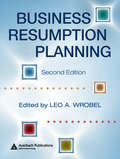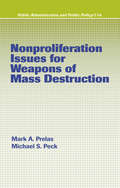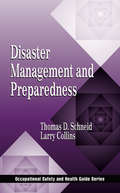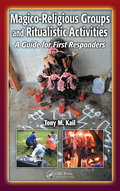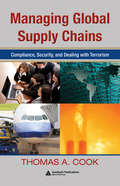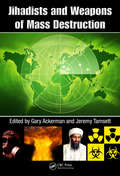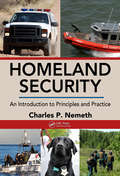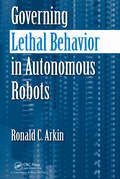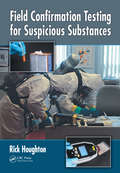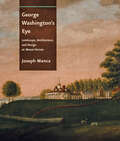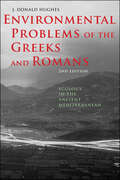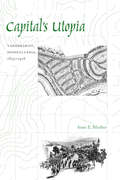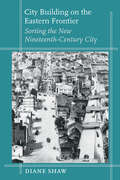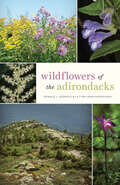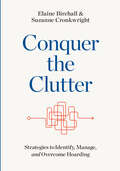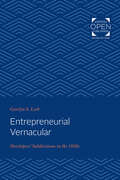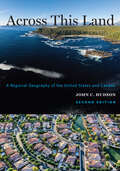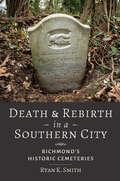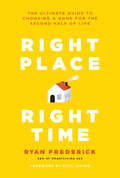- Table View
- List View
Business Resumption Planning
by Leo A. WrobelOffering hundreds of tips, templates, checklists, and pointers to information in the public domain, Business Resumption Planning, Second Edition assists you in creating a rock solid recovery plan for any size organization. It provides the information you need in order to coordinate first responders to meet any disaster scenario head on, whet
Nonproliferation Issues For Weapons of Mass Destruction
by Mark A. Prelas Michael PeckNonproliferation Issues for Weapons of Mass Destruction provides an understanding of WMD proliferation risks by bridging complex technical and political issues. The text begins by defining the world conditions that foster proliferation, followed by an analysis of characteristics of various classes of WMDs, including nuclear, biological, and chemica
Disaster Management and Preparedness
by Larry R. CollinsDetailing methods for preparing organizations for disasters, this book discusses not only tried and true tactics, but also areas often overlooked during the reactive and post-disaster phases. The authors address special considerations important in planning for disaster management, from chemical spills, floods, aircraft crashes, and terrorist attack
Magico-Religious Groups and Ritualistic Activities: A Guide for First Responders
by Tony M. KailA woman lays unconscious on the floor surrounded by charcoaled symbols, burning candles, a bowl of viscous red liquid, and an array of dried herbs. Was this a healing ritual gone wrong or just straightforward foul play? Increasingly, first responders must deal with foreign practices and cultures that are often disturbing in their unfamiliarity. Und
Managing Global Supply Chains: Compliance, Security, and Dealing with Terrorism
by Thomas A. CookSeptember 11, 2001 had a profound impact upon individuals, institutions, and governments, but also upon the world of global trade. Years later, the reverberations of this deliberate and focused act of terrorism are manifest in much more stringent logistics, documentary requirements, and regulations. A single source on compliance and security, writt
Jihadists and Weapons of Mass Destruction
by Gary Ackerman Jeremy TamsettExplores the Nexus Formed When Malevolent Actors Access Malignant MeansWritten for professionals, academics, and policymakers working at the forefront of counterterrorism efforts, Jihadists and Weapons of Mass Destruction is an authoritative and comprehensive work addressing the threat of weapons of mass destruction (WMD) in the hands of jihadists,
Homeland Security: An Introduction to Principles and Practice
by Charles P. NemethSince its formation in 2002�the largest government reorganization since FDR�s "New Deal"�the Department of Homeland Security (DHS) has focused on a broad range of public policy, safety, and security issues. From responsible intelligence gathering and combating global terrorism to securing critical infrastructure and disaster planning and response,
Governing Lethal Behavior in Autonomous Robots
by Ronald ArkinExpounding on the results of the author's work with the US Army Research Office, DARPA, the Office of Naval Research, and various defense industry contractors, Governing Lethal Behavior in Autonomous Robots explores how to produce an "artificial conscience" in a new class of robots, humane-oids, which are robots that can potentially perform more et
Field Confirmation Testing for Suspicious Substances
by Rick HoughtonFrequently a substance found at a port of entry, waste site, laboratory triage facility, or even in a hazardous materials emergency will be labeled and purportedly identified. But law enforcement and other first responders cannot take this claim at face value, as the accuracy is not confirmed and must be verified. A comprehensive handbook for on-th
George Washington's Eye: Landscape, Architecture, and Design at Mount Vernon
by Joseph MancaOn the banks of the Potomac River, Mount Vernon stands, with its iconic portico boasting breathtaking views and with a landscape to rival the great gardens of Europe, as a monument to George Washington’s artistic and creative efforts. More than one million people visit Mount Vernon each year—drawn to the stature and beauty of Washington’s family estate.Art historian Joseph Manca systematically examines Mount Vernon—its stylistic, moral, and historical dimensions—offering a complete picture of this national treasure and the man behind its enduring design. Manca brings to light a Washington deeply influenced by his wide travels in colonial America, with a broader architectural knowledge than previously suspected, and with a philosophy that informed his aesthetic sensibility. Washington believed that design choices and personal character mesh to form an ethic of virtue and fulfillment and that art is inextricably linked with moral and social concerns. Manca examines how these ideas shaped the material culture of Mount Vernon.Based on careful study of Washington’s personal diaries and correspondence and on the lively accounts of visitors to his estate, this richly illustrated book introduces a George Washington unfamiliar to many readers—an avid art collector, amateur architect, and leading landscape designer of his time.
Environmental Problems of the Greeks and Romans: Ecology in the Ancient Mediterranean (Ancient Society and History)
by J. Donald HughesIn this dramatically revised and expanded second edition of the work entitled Pan’s Travail, J. Donald Hughes examines the environmental history of the classical period and argues that the decline of ancient civilizations resulted in part from their exploitation of the natural world. Focusing on Greece and Rome, as well as areas subject to their influences, Hughes offers a detailed look at the impact of humans and their technologies on the ecology of the Mediterranean basin. Evidence of deforestation in ancient Greece, the remains of Roman aqueducts and mines, and paintings on centuries-old pottery that depict agricultural activities document ancient actions that resulted in detrimental consequences to the environment. Hughes compares the ancient world's environmental problems to other persistent social problems and discusses attitudes toward nature expressed in Greek and Latin literature. In addition to extensive revisions based on the latest research, this new edition includes photographs from Hughes's worldwide excursions, a new chapter on warfare and the environment, and an updated bibliography.
Capital's Utopia: Vandergrift, Pennsylvania, 1855-1916 (Creating the North American Landscape)
by Anne E. MosherIn the 1890s the Apollo Iron and Steel Company ended a bitterly contested labor dispute by hiring replacement workers from the surrounding countryside. To avoid future unrest, however, the company sought to gain tighter control over its workers not only at the factory but also in their homes. Drawing upon a philosophy of reform movements in Europe and the United States, the firm decided that providing workers with good housing and a good urban environment would make them more loyal and productive. In 1895, Apollo Iron and Steel built a new, integrated, non-unionized steelworks and hired the nation's preeminent landscape architectural firm (Olmsted, Olmsted, and Eliot) to design the model industrial town: Vandergrift.In Capital's Utopia: Vandergrift, Pennsylvania, 1855-1916, Anne E. Mosher offers the first comprehensive geographical overview of the industrial restructuring of an American steelworks and its workforce in the late nineteenth–century. In addition, by offering a thorough analysis of the Olmsted plan, Mosher integrates historical geography and labor history with landscape architectural history and urban studies. As a result, this book is far more than a case study. It is a window into an important period of industrial development and its consequences on communities and environments in the world-famous steel country of southwestern Pennsylvania.
City Building on the Eastern Frontier: Sorting the New Nineteenth-Century City (Creating the North American Landscape)
by Diane ShawAmerica's westward expansion involved more than pushing the frontier across the Mississippi toward the Pacific; it also consisted of urbanizing undeveloped regions of the colonial states. In 1810, New York's future governor DeWitt Clinton marveled that the "rage for erecting villages is a perfect mania." The development of Rochester and Syracuse illuminates the national experience of internal economic and cultural colonization during the first half of the nineteenth century. Architectural historian Diane Shaw examines the ways in which these new cities were shaped by a variety of constituents—founders, merchants, politicians, and settlers—as opportunities to extend the commercial and social benefits of the market economy and a merchant culture to America's interior. At the same time, she analyzes how these priorities resulted in a new approach to urban planning.According to Shaw, city founders and residents deliberately arranged urban space into three segmented districts—commercial, industrial, and civic—to promote a self-fulfilling vision of a profitable and urbane city. Shaw uncovers a distinctly new model of urbanization that challenges previous paradigms of the physical and social construction of nineteenth-century cities. Within two generations, the new cities of Rochester and Syracuse were sorted at multiple scales, including not only the functional definition of districts, but also the refinement of building types and styles, the stratification of building interiors by floor, and even the coding of public space by class, gender, and race. Shaw's groundbreaking model of early nineteenth-century urban design and spatial culture is a major contribution to the interdisciplinary study of the American city.
Wildflowers of the Adirondacks
by Lytton Musselman Donald LeopoldCovering more than six million acres of protected wilderness, the Adirondacks, with their landscape of high peaks, verdant wetlands, majestic trees, and lush carpets of flowers, is a pristine paradise for nature lovers. The only available identification guide to the Adirondack region's wildflowers, this comprehensive resource is packed with more than 300 gorgeous color images, one to represent almost every flower commonly found in this huge range. Revealing the stunning diversity of Adirondack wildflowers, from goldenrod and marsh blue violet to cattails and hellebore, the book includes • detailed botanical species accounts, arranged by flower color• images of each flower that highlight key features for easy ID• information about each species' natural history• descriptions of the region's upland, wetland, and aquatic habitats• a special section on the nearly 40 terrestrial orchid species found in the AdirondacksWritten by Donald J. Leopold and Lytton John Musselman, skilled botanists and the foremost authorities on these plants, this superior quality guide will appeal to residents of and visitors to the Adirondacks and northeastern mountains, including wildlife professionals, citizen scientists, backpackers, campers, photographers, bird watchers, artists, and wild food foragers.
Wildflowers of the Adirondacks (PDF)
by Lytton Musselman Donald LeopoldCovering more than six million acres of protected wilderness, the Adirondacks, with their landscape of high peaks, verdant wetlands, majestic trees, and lush carpets of flowers, is a pristine paradise for nature lovers. The only available identification guide to the Adirondack region's wildflowers, this comprehensive resource is packed with more than 300 gorgeous color images, one to represent almost every flower commonly found in this huge range. Revealing the stunning diversity of Adirondack wildflowers, from goldenrod and marsh blue violet to cattails and hellebore, the book includes • detailed botanical species accounts, arranged by flower color• images of each flower that highlight key features for easy ID• information about each species' natural history• descriptions of the region's upland, wetland, and aquatic habitats• a special section on the nearly 40 terrestrial orchid species found in the AdirondacksWritten by Donald J. Leopold and Lytton John Musselman, skilled botanists and the foremost authorities on these plants, this superior quality guide will appeal to residents of and visitors to the Adirondacks and northeastern mountains, including wildlife professionals, citizen scientists, backpackers, campers, photographers, bird watchers, artists, and wild food foragers.
Conquer the Clutter: Strategies to Identify, Manage, and Overcome Hoarding
by Elaine Birchall Suzanne CronkwrightWhy does Cliff, a successful lawyer who regularly wins landmark cases, step over two-foot piles of paper whenever he opens his front door? Why do Joan and Paul ask Children's Services to take their three children instead of decluttering their home? Why does Lucinda feel intense pressure to hold onto her family's heirlooms even though she has no room for them? They have hoarding disorder, which an estimated 2% to 6% of the adult population worldwide experience.Conquer the Clutter offers hope to anyone affected by hoarding. Real-life vignettes, combined with easy-to-use assessment and intervention tools, support those who hoard—and those who care about them. Written by Elaine Birchall, a social worker dedicated to helping people declutter and achieve long-term control over their belongings, the book• provides an overview of hoarding, defining what it is—and is not• explains the difference between clutter and hoarding • describes different types of hoarding in detail, including impulse shopping, "closet" hoarding, and animal hoarding• debunks myths about hoarding and hoarders • explores the effects that hoarding has on relationships, on work, and on physical and financial health• presents a practical, step-by-step plan of action for decluttering• contains dedicated advice from individuals who have successfully overcome their hoarding disorderThe most comprehensive work about hoarding on the market, Conquer the Clutter discusses special populations who are not often singled out, such as the disabled and the elderly, and includes numerous worksheets to assist individuals in determining the scope of their hoarding disorder and tackling the problem.
Conquer the Clutter: Strategies to Identify, Manage, and Overcome Hoarding
by Elaine Birchall Suzanne CronkwrightWhy does Cliff, a successful lawyer who regularly wins landmark cases, step over two-foot piles of paper whenever he opens his front door? Why do Joan and Paul ask Children's Services to take their three children instead of decluttering their home? Why does Lucinda feel intense pressure to hold onto her family's heirlooms even though she has no room for them? They have hoarding disorder, which an estimated 2% to 6% of the adult population worldwide experience.Conquer the Clutter offers hope to anyone affected by hoarding. Real-life vignettes, combined with easy-to-use assessment and intervention tools, support those who hoard—and those who care about them. Written by Elaine Birchall, a social worker dedicated to helping people declutter and achieve long-term control over their belongings, the book• provides an overview of hoarding, defining what it is—and is not• explains the difference between clutter and hoarding • describes different types of hoarding in detail, including impulse shopping, "closet" hoarding, and animal hoarding• debunks myths about hoarding and hoarders • explores the effects that hoarding has on relationships, on work, and on physical and financial health• presents a practical, step-by-step plan of action for decluttering• contains dedicated advice from individuals who have successfully overcome their hoarding disorderThe most comprehensive work about hoarding on the market, Conquer the Clutter discusses special populations who are not often singled out, such as the disabled and the elderly, and includes numerous worksheets to assist individuals in determining the scope of their hoarding disorder and tackling the problem.
Entrepreneurial Vernacular: Developers' Subdivisions in the 1920s (Creating the North American Landscape)
by Carolyn S. LoebOriginally published in 2001. Suburban subdivisions of individual family homes are so familiar a part of the American landscape that it is hard to imagine a time when they were not common in the U. S. The shift to large-scale speculative subdivisions is usually attributed to the period after World War II. In Entrepreneurial Vernacular: Developers' Subdivisions in the 1920s, Carolyn S. Loeb shows that the precedents for this change in single-family home design were the result of concerted efforts by entrepreneurial realtors and other housing professionals during the 1920s. In her discussion of the historical and structural forces that propelled this change, Loeb focuses on three typical speculative subdivisions of the 1920s and on the realtors, architects, and building-craftsmen who designed and constructed them. These examples highlight the "shared set of planning and design concerns" that animated realtors (whom Loeb sees as having played the "key role" in this process) and the network of housing experts with whom they associated. Decentralized and loosely coordinated, this network promoted home ownership through flexible strategies of design, planning, financing, and construction which the author describes as a new and "entrepreneurial" vernacular.
Entrepreneurial Vernacular: Developers' Subdivisions in the 1920s (Creating the North American Landscape)
by Carolyn S. LoebOriginally published in 2001. Suburban subdivisions of individual family homes are so familiar a part of the American landscape that it is hard to imagine a time when they were not common in the U. S. The shift to large-scale speculative subdivisions is usually attributed to the period after World War II. In Entrepreneurial Vernacular: Developers' Subdivisions in the 1920s, Carolyn S. Loeb shows that the precedents for this change in single-family home design were the result of concerted efforts by entrepreneurial realtors and other housing professionals during the 1920s. In her discussion of the historical and structural forces that propelled this change, Loeb focuses on three typical speculative subdivisions of the 1920s and on the realtors, architects, and building-craftsmen who designed and constructed them. These examples highlight the "shared set of planning and design concerns" that animated realtors (whom Loeb sees as having played the "key role" in this process) and the network of housing experts with whom they associated. Decentralized and loosely coordinated, this network promoted home ownership through flexible strategies of design, planning, financing, and construction which the author describes as a new and "entrepreneurial" vernacular.
Across This Land: A Regional Geography of the United States and Canada (Creating the North American Landscape)
by John HudsonBased on decades of research and written in clear, concise prose by one of the foremost geographers in North America, John C. Hudson's Across This Land is a comprehensive regional geography of the North American continent. Dividing the terrain into ten regions, which are then subdivided into twenty-seven smaller areas, Hudson's brisk narrative reveals the dynamic processes of each area's distinctive place-specific characteristics. Focusing on how human activities have shaped and have been shaped by the natural environment, Hudson considers physical, political, and historical geography. He also highlights related topics, including resource exploitation, economic development, and population change. Praised in its first edition as a readable and reliable interpretation of United States and Canadian geography, the revised Across This Land retains these strengths while adding substantial new material. Incorporating the latest available population and economic data, this thoroughly updated edition includes• reflections on new developments, such as resource schemes, Native governments in Atlantic Canada, and the role of climate change in the Arctic• a new section focused on the US Pacific insular territories west of Hawaii• evolving views of oil and gas production resulting from the introduction of hydraulic fracturing• revised text and maps involving agricultural production based on the 2017 Census of Agriculture• current place names• more than 130 photographsThe most extensive regional geography of the North American continent on the market, Hudson's Across This Land will continue as the standard text in geography courses dealing with Canada and the United States, as well as a popular reference work for scholars, students, and lay readers.
Across This Land: A Regional Geography of the United States and Canada (Creating the North American Landscape)
by John HudsonBased on decades of research and written in clear, concise prose by one of the foremost geographers in North America, John C. Hudson's Across This Land is a comprehensive regional geography of the North American continent. Dividing the terrain into ten regions, which are then subdivided into twenty-seven smaller areas, Hudson's brisk narrative reveals the dynamic processes of each area's distinctive place-specific characteristics. Focusing on how human activities have shaped and have been shaped by the natural environment, Hudson considers physical, political, and historical geography. He also highlights related topics, including resource exploitation, economic development, and population change. Praised in its first edition as a readable and reliable interpretation of United States and Canadian geography, the revised Across This Land retains these strengths while adding substantial new material. Incorporating the latest available population and economic data, this thoroughly updated edition includes• reflections on new developments, such as resource schemes, Native governments in Atlantic Canada, and the role of climate change in the Arctic• a new section focused on the US Pacific insular territories west of Hawaii• evolving views of oil and gas production resulting from the introduction of hydraulic fracturing• revised text and maps involving agricultural production based on the 2017 Census of Agriculture• current place names• more than 130 photographsThe most extensive regional geography of the North American continent on the market, Hudson's Across This Land will continue as the standard text in geography courses dealing with Canada and the United States, as well as a popular reference work for scholars, students, and lay readers.
Death and Rebirth in a Southern City: Richmond's Historic Cemeteries
by Ryan K. SmithRichmond, Virginia, the former capital of the Confederacy, holds one of the most dramatic landscapes of death in the nation. Its burial grounds show the sweep of Southern history on an epic scale, from the earliest English encounters with the Powhatan at the falls of the James River through slavery, the Civil War, and the long reckoning that followed. And while the region's deathways and burial practices have developed in surprising directions over these centuries, one element has remained stubbornly the same: the color line. But something different is happening now. The latest phase of this history points to a quiet revolution taking place in Virginia and beyond. Where white leaders long bolstered their heritage and authority with a disregard for the graves of the disenfranchised, today activist groups have stepped forward to reorganize and reclaim the commemorative landscape for the remains of people of color and religious minorities. In Death and Rebirth in a Southern City, Ryan K. Smith explores more than a dozen of Richmond's most historically and culturally significant cemeteries. He traces the disparities between those grounds which have been well-maintained, preserving the legacies of privileged whites, and those that have been worn away, dug up, and built over, erasing the memories of African Americans and indigenous tribes. Drawing on extensive oral histories and archival research, Smith unearths the heritage of these marginalized communities and explains what the city must do to conserve these gravesites and bring racial equity to these arenas for public memory. He also shows how the ongoing recovery efforts point to a redefinition of Confederate memory and the possibility of a rebirthed community in the symbolic center of the South.The book encompasses, among others, St. John's colonial churchyard; African burial grounds in Shockoe Bottom and on Shockoe Hill; Hebrew Cemetery; Hollywood Cemetery, with its 18,000 Confederate dead; Richmond National Cemetery; and Evergreen Cemetery, home to tens of thousands of black burials from the Jim Crow era. Smith's rich analysis of the surviving grounds documents many of these sites for the first time and is enhanced by an accompanying website, www.richmondcemeteries.org. A brilliant example of public history, Death and Rebirth in a Southern City reveals how cemeteries can frame changes in politics and society across time.
Death and Rebirth in a Southern City: Richmond's Historic Cemeteries
by Ryan K. SmithRichmond, Virginia, the former capital of the Confederacy, holds one of the most dramatic landscapes of death in the nation. Its burial grounds show the sweep of Southern history on an epic scale, from the earliest English encounters with the Powhatan at the falls of the James River through slavery, the Civil War, and the long reckoning that followed. And while the region's deathways and burial practices have developed in surprising directions over these centuries, one element has remained stubbornly the same: the color line. But something different is happening now. The latest phase of this history points to a quiet revolution taking place in Virginia and beyond. Where white leaders long bolstered their heritage and authority with a disregard for the graves of the disenfranchised, today activist groups have stepped forward to reorganize and reclaim the commemorative landscape for the remains of people of color and religious minorities. In Death and Rebirth in a Southern City, Ryan K. Smith explores more than a dozen of Richmond's most historically and culturally significant cemeteries. He traces the disparities between those grounds which have been well-maintained, preserving the legacies of privileged whites, and those that have been worn away, dug up, and built over, erasing the memories of African Americans and indigenous tribes. Drawing on extensive oral histories and archival research, Smith unearths the heritage of these marginalized communities and explains what the city must do to conserve these gravesites and bring racial equity to these arenas for public memory. He also shows how the ongoing recovery efforts point to a redefinition of Confederate memory and the possibility of a rebirthed community in the symbolic center of the South.The book encompasses, among others, St. John's colonial churchyard; African burial grounds in Shockoe Bottom and on Shockoe Hill; Hebrew Cemetery; Hollywood Cemetery, with its 18,000 Confederate dead; Richmond National Cemetery; and Evergreen Cemetery, home to tens of thousands of black burials from the Jim Crow era. Smith's rich analysis of the surviving grounds documents many of these sites for the first time and is enhanced by an accompanying website, www.richmondcemeteries.org. A brilliant example of public history, Death and Rebirth in a Southern City reveals how cemeteries can frame changes in politics and society across time.
Right Place, Right Time: The Ultimate Guide to Choosing a Home for the Second Half of Life
by Ryan FrederickWondering where to live in your later years? This strategic and thoughtful guide is aimed at anyone looking to determine the best place to call home during the second half of life.Place plays a significant but often unacknowledged role in health and happiness. The right place elevates personal well-being. It can help promote purpose, facilitate human connection, catalyze physical activity, support financial health, and inspire community engagement. Conversely, the wrong place can be detrimental to health, as the COVID-19 pandemic has highlighted. In Right Place, Right Time, Ryan Frederick argues that where you live matters enormously—especially during the second half of your life. Frederick, the CEO of SmartLiving 360 and a recognized thought leader on the intersection of place and healthy aging, provides you with tools to evaluate your living situation, ensuring that you weigh all the necessary factors to make a sound decision that optimizes your current and future well-being. He explores the pros and cons of different living options, from remaining in your current home to downsizing, intergenerational living, co-housing, senior living, and more. Along the way, he helps readers answer important questions, including "Are you already in the right place?" and "In what areas does your current place not align with your needs and desires?" The rest of the book helps you to unpack specific options for place, beginning with considerations for regions and neighborhoods and then looking at specific housing models. It also focuses on how housing is changing, particularly from a technology, health, and health care perspective. The book closes by challenging the reader to develop a discipline of choosing the right place at the right time.Combining real-life stories about people selecting places to live with design thinking principles and interactive tools, Right Place, Right Time will appeal to empty nesters, retirees, solo agers, and even adult children seeking ways to support their parents and loved ones.
Right Place, Right Time: The Ultimate Guide to Choosing a Home for the Second Half of Life
by Ryan FrederickWondering where to live in your later years? This strategic and thoughtful guide is aimed at anyone looking to determine the best place to call home during the second half of life.Place plays a significant but often unacknowledged role in health and happiness. The right place elevates personal well-being. It can help promote purpose, facilitate human connection, catalyze physical activity, support financial health, and inspire community engagement. Conversely, the wrong place can be detrimental to health, as the COVID-19 pandemic has highlighted. In Right Place, Right Time, Ryan Frederick argues that where you live matters enormously—especially during the second half of your life. Frederick, the CEO of SmartLiving 360 and a recognized thought leader on the intersection of place and healthy aging, provides you with tools to evaluate your living situation, ensuring that you weigh all the necessary factors to make a sound decision that optimizes your current and future well-being. He explores the pros and cons of different living options, from remaining in your current home to downsizing, intergenerational living, co-housing, senior living, and more. Along the way, he helps readers answer important questions, including "Are you already in the right place?" and "In what areas does your current place not align with your needs and desires?" The rest of the book helps you to unpack specific options for place, beginning with considerations for regions and neighborhoods and then looking at specific housing models. It also focuses on how housing is changing, particularly from a technology, health, and health care perspective. The book closes by challenging the reader to develop a discipline of choosing the right place at the right time.Combining real-life stories about people selecting places to live with design thinking principles and interactive tools, Right Place, Right Time will appeal to empty nesters, retirees, solo agers, and even adult children seeking ways to support their parents and loved ones.
